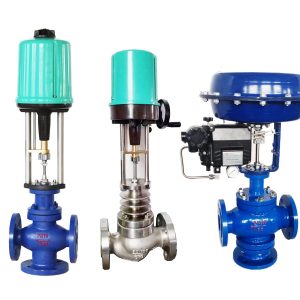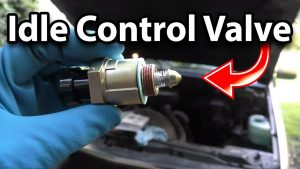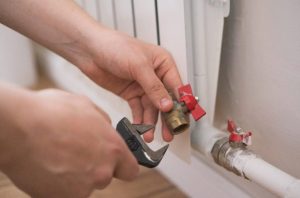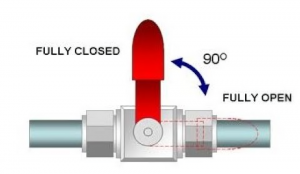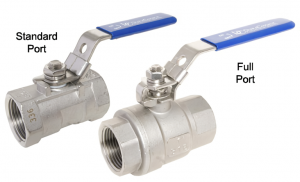How a Ball Valve Works?
Generally speaking, the ball valve working mechanism works this way. Whether it is manually or actuator operated, some force moves the lever or handle to a quarter turn to open the valve. This force is transferred to the stem, moving the disc to open.
The ball disc turns and its hollowed side faces the flow of media. At this point, the lever is in the perpendicular position and the port to parallel in relation to the flow of media. There is a handle stop near the connection between the stem and bonnet to only allow a quarter-turn.
To close the valve, the lever moves back a quarter turn. The stem moves to turn the ball disc in the opposite direction, blocking the flow of media. The lever is in the parallel position and the port, perpendicular.
However, take note that there are three kinds of ball disc movement. Each of these has different working operations.
The floating ball valve has its ball disc suspended on the stem. There is no support at the bottom part of the ball so the ball disc partially relies on the internal pressure for the tight seal ball valves are known for.
As the valve closes, the upstream linear pressure from the media pushes the ball towards the cupped downstream seat. This provides a positive valve tightness, adding to its sealing factor. The downstream seat of the floating ball valve design carries the load of the internal pressure when the valve is closed.
The other kind of ball disc design is the trunnion mounted ball valve. This has a set of trunnions at the bottom of the ball disc, making the ball disc stationary. These trunnions also absorb the force from the pressure load when the valve closes so there is less friction between the ball disc and the seat. Sealing pressure is performed in both upstream and downstream ports.
When the valve closes, spring-loaded seats move against the ball which only rotates in its own axis. These springs push the seat tightly to the ball. Trunnion mounted ball types are suitable for applications that don’t need high pressure to move the ball to the downstream seat.
Lastly, the rising stem ball valve utilizes the tilt-and-turn mechanism. The ball disc wedges to the seat when the valve closes. When it opens, the disc tilts to remove itself from the seat and allow media flow.
Parts of Ball Valve
Ball valves are constructed with several crucial components:
- Valve Body
This is the main part of the valve and contains all of the components for on/off control.
- Rotary Ball
The ball is designed with a center bore (hole) that the media flows through. The direction of the ball is controlled by turning the stem.
- Stem
This connects the ball to the external control mechanism. For example, in a manual ball valve the stem is connected to a handle or lever.
- Seats
These are discs that lie in between the body and the ball. Seats provide a seal between the two and also support the ball.
- Power Source
The stem of the ball valve is rotated using manual or actuated power sources. Manual actuation includes levers and handles that are controlled by an operator. Automated power sources like electric, pneumatic and hydraulic actuation are also available.
- Packing
This is a seal around the stem that prevents the media from escaping.
- Bonnet
The bonnet is the part of the body that contains the stem and packing.
Ball Valve Repair Kit
- 1 Ball
- 2 Seats
- 1 Upper Bearing
- 1 Lower Bearing
- 1 Viton O-Ring
- Instructions
Ball Valve Repair
The Valve Ball is Overturned
Troubleshooting: the assembly shall be correct, the operation shall be stable, and it is not allowed to be used as a throttle valve; the ball shall be repaired and the seal seat shall be replaced in time after being turned over.
When Used As a Throttling Function, the Ball Valve Sealing Surface is Damaged
Troubleshooting: industrial ball valve is not allowed to be used for throttling.
The Valve Sealing Surface is Crushed
Troubleshooting: tighten the bolts at the valve seat evenly with a small force. It is better to tighten them several times rather than too much and too tight at one time. The damaged sealing surface can be repaired by grinding and scraping.
There is No Pre Tightening Pressure on the Sealing Surface
Troubleshooting: the pre tightening pressure of the sealing surface of the industrial valve seat shall be checked regularly. In case of leakage or loose contact of the sealing surface, the sealing surface of the valve seat shall be pressed a little; the failure of the pre-pressing spring shall be replaced.
There is a Large Gap at the Joint of the Wrench, Valve Rod and Ball
The wrench has reached the closed position, and the ball rotation angle is less than 90 degrees, resulting in long-term leakage.
Troubleshooting: if the joint of spanner, stem and ball of the limited mechanism is loose and the gap is too large, repair it and fasten it firmly; adjust the limit block, eliminate the advance angle of spanner, and make the ball open and close correctly.
The Contact Surface Between the Ball Valve Seat and the Body is Not Smooth and Worn
The O-ring is damaged, causing the valve seat to leak.
Troubleshooting: improve the surface finish of the contact surface between the valve seat and the body, reduce the number of valve seat disassembly, and replace the O-ring regularly.






